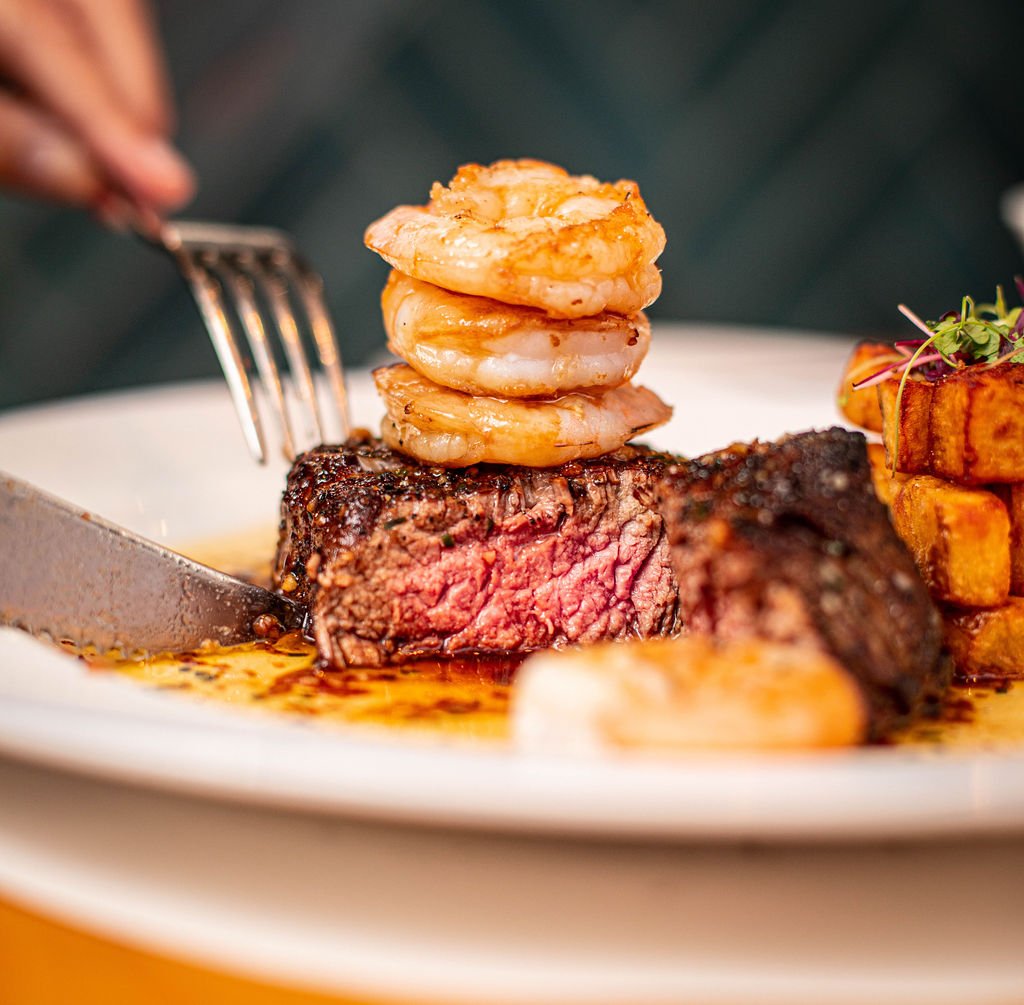Surf and Turf at Gamba: Best Surf & Turf in Glasgow
Australians call it Beef and Reef. In Spain, it’s Mar y Tierra. It’s Surf and Turf to us, and if your mouth’s watering and you’re yet to try our terrific Wednesday Surf & Turf deal, forget Googling ‘surf and turf near me’ or ‘best surf and turf near me’ because our customers say Gamba’s is the best in Glasgow. Outstanding value, too.
The ‘surf’ part refers to seafood, and the ‘turf’ to animals that feed on grass (cows), so this can mean a few meat/seafood combos. How we do it at Gamba is two Scotch fillet steaks, juicy jumbo king prawns, scallop, garlic butter, those famous Gamba chunky chips, plus a bottle of Fiano, Masseria Bianco, or Mucchietto IGT Primitivo del Salento 2020 - both Puglia, Italy – for only £90 for two persons.
Where did Surf n Turf originate?
We did some digging into where Surf n Turf originated.
One theory says that Surf and Turf started across the pond, with Indigenous people living in North America's coastal regions cottoning on to this amazing pairing of flavours as far back as the 17th century.
It’s said that they celebrated special occasions with surf and turf-style feasts - typically venison, wild turkey, or similar fowl served with clams, eel, cod, and lobster.
Fast forward to late 19th-century America and combining large portions of lobster and steak took off in show restaurants, aka lobster palaces, but by the 1920s it had fallen out of fashion. The term Surf and Turf started appearing on both coasts of America around 1939 but referred to beach-related stuff, like beach bags and bathing suits, rather than food.
It wasn’t until the 1960s that it was used to mean what we know it as today, and both the West and East coasts of America lay claim to cradling the trend.
Surf & Turf: West Coast or East Coast?
Where Surf ‘n' Turf popped up first on American restaurant menus is a great big juicy bone of contention.
Did it originate on the West Coast, in Seattle, Washington, or the East Coast, in Lowell, Massachusetts?
Some believe it first appeared in the Seattle Space Needle restaurant, Eye of the Needle, at the 1962 World’s Fair, while others argue the actual term made its debut in 1966 in Massachusetts newspaper, The Lowell Sun, in an advertisement that read: ‘surf ‘n turf dinner featuring filet mignon and baked stuffed Alaskan crab legs.’
Whether on the Atlantic or Pacific coast where seafood was ample, we do know that restaurants began pairing it with steak in the 1960s, and that it took off to such an extent, often served at formal events such as weddings, banquets, and other special occasions, that February 29th became and remains National Surf & Turf Day.
Another Surf & Turf Origins Theory
Another theory is that Surf & Turf can be traced back to the peasant uprisings of medieval Europe. During the Middle Ages, European societies like Britain and France were organised into feudal systems, where lords would be granted fiefdoms by the king. This meant that in return for the military and economic backup of the monarch these lords had control over a plot of land.
The peasant class were known as ‘serfs’ and they were bought and sold with the land they farmed, yet had no political rights, and there were eventually uprisings.
Serf independence movements first emerged in Western Europe in the mid-14th century, including in Scotland, Wales, and southern France, and lords were overwhelmed with demands for ‘Turf for Serfs.’
Surf and Turf still going strong
So, there you have it. The potted history of Surf and Turf, and It’s still going strong.
When America sneezes, the rest of the world usually catches the cold, and following its resurgence in popularity in steakhouses and restaurants across the States in the 1960s, Surf and Turf spread to Canada and the UK, like Simpson’s-on-The-Strand in London where it first appeared on the menu in 1963, and we don’t see it disappearing from our menu at Gamba anytime soon.
By Jason Caddy

